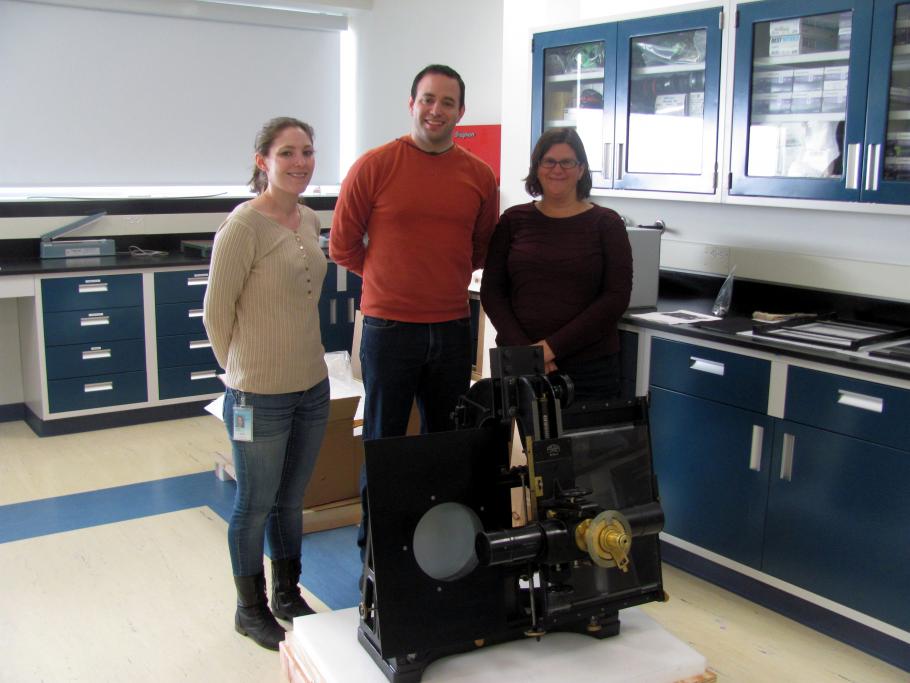It all started at a special public lecture at the Museum in July 2014 given by Alan Stern, the lead scientist for the New Horizons mission, which will fly past Pluto this July. Among the attendees was William Lowell Putnam IV, sole trustee of the Lowell Observatory in Flagstaff, Arizona—the place where Pluto was found in 1930 by Clyde Tombaugh. It was an exciting evening, not only to learn about the impending flyby but also having a chance to speak with Putnam and the director of the Lowell Observatory, Jeff Hall. I shared with them the Museum’s plans for an upcoming display of a full-scale, mock-up of the New Horizons spacecraft. We had acquired the model from the Johns Hopkins University’s Applied Physics Laboratory in late 2007. It was initially on temporary display at the Udvar-Hazy Center in Chantilly, Virginia, but at the time of our conversation it was slated for transfer to the Museum in Washington, DC in an upgraded Exploring the Planets gallery, in time for the flyby. Upon hearing of our plans, Putnam suggested that we might like to juxtapose New Horizons with the instrument that Tombaugh used at Lowell to find Pluto in the first place. After all, a portion of Tombaugh’s ashes were sent aboard New Horizons to meet the planet he discovered. Why not commemorate the link by placing the device he used to make the discovery next to the full-scale model?
We excitedly agreed to the generous offer, appreciating that the loan was one of the most significant instruments from Lowell Observatory’s history. On my many visits to the Observatory, partly because I am a member of its advisory board, I always stopped in at the Slipher Building to see the displays celebrating the discovery of Pluto. It shared center stage with another of Lowell’s feats: a spectrograph that V. M. Slipher used on the Lowell Observatory’s 61-centimeter (24-inch) refractor in the years 1912 through 1915 to make the first detections of the expanding universe.
The device that Tombaugh used to discover Pluto did not work in a telescope dome, but in an office. It is a special form of microscope that allows the user to examine and compare two photographic plates in very close order. The photographic plates Tombaugh was comparing with this machine were 36 x 43 centimeters (14 x 17 inches), and were long exposures taken with a telescopic camera that sported a powerful 33-centimeter (13-inch) diameter lens. Tombaugh took exposures at night, covering areas of the sky where Percival Lowell had predicted years earlier that a planet must be lurking. He then developed those plates, and during the day compared them, spending weeks and months searching vast depths of space looking for something moving among the thousands of stars exposed on those plates. In February 1930, finally, he found something that he could not explain away as a nearby asteroid or some other form of space debris. It moved too slowly to be an asteroid. If it was a planet, it was farther than Neptune, just as Lowell predicted.
Tombaugh operated the instrument, built by the Zeiss company and popularly called a “blink comparator,” by rotating a small dial that flipped a mirror back and forth between the beams from two microscopes. Blinking between two plates taken on January 23 and 29, 1930, he found something. The below animation is flipping between the two plates. Can you find it? If you're having trouble spotting Pluto, take a look at the next animation with arrows marking the elusive object. It’s not an easy job, to be sure. The time exposures do not always yield the same brightness, and the orientation of the two fields is not exact.
Following up on Putnam’s offer, I contacted Samantha Thompson, who curates the exhibits and archives at Lowell Observatory. Sam was an intern here several years ago and then went on for graduate training in the history of science at Imperial College and then at UC Santa Barbara. Given that Putnam made the offer, she readily complied and set the wheels in motion at Lowell to dismantle a portion of their display, making it ready for a custom art shipper to pack and ship it to Washington.
The blink arrived at the National Air and Space Museum’s Emil Buehler Conservation Laboratory at the Udvar-Hazy Center in late March. A team of conservation staff, led by Lisa Young, set to work cleaning it, evaluating it, and taking care that all conditions for display would be met. At the Lowell Observatory, visitors could press a button and solenoids would flip the mirror remotely. The Lowell staff made this modification in the 1990s for their display, and it worked nicely. Visitors could peer through the actual eyepiece, though they could not touch the rest of the instrument itself as it sat inside a Plexiglas case. We decided, however, that even this creative solution was insufficient to guarantee full protection under the conditions we have found to be common at the Museum in Washington, DC with its millions of visitors. Our goal was to remove any chance that a visitor could remove something, or insert something into the vitrine. In three years, the instrument will be returned to the Lowell Observatory 100% intact. While we will completely protect the blink within a case, a video will show how the blinking takes place, complete with arrows of course!
We’re excited to share this incredible artifact and the story of the blink comparator in our Exploring the Planets gallery and online. Were you able to spot the moving planet or did you need the help of the arrows?

